Improvement of System of Special Physical Training of Athletes of Complex (Mixed) Martial Arts
Фотографии:
ˑ:
S.M. Ashkinazi, professor, Dr.Hab.
Lesgaft National State University of Physical Culture, Sport and Health, St. Petersburg
E.A. Bavykin
National University of Mineral Resources (Mining University), St. Petersburg
Key words: complex and mixed martial arts, conditioning and special physical training, endurance.
Introduction. In the last 25-30 years martial arts have become very popular among young people of our country and in the world in general and involved in its techniques hand, feet striking techniques and wrestling techniques: hand to hand combat, military melee, universal fight, Wushu Sanda, sport and combat sambo, pankration, applied sports karate, jiu-jitsu, MMA (mixed fight), kudo, etc. They can be combined into a group of the so-called complex, or mixed, martial arts. Most of the above sports have their sports federations accredited in Rossport, and are included in the Unified Sports Classification System of Russia. Regional, national and international tournaments, up to championships and world championships, are held in these sports among both senior and junior athletes [1, 2].
The ever-growing competition in complex (mixed) martial arts proves that new methods and techniques for sports training should be developed, which could meet the requirements to the limit, made by the specificity of this sport. Moreover, there is much tension about the issue of special physical training, and of development of those special physical qualities the display of which determines the success in competitive activity on the whole. Theoretical researches, as well as mixed martial arts practice, indicate the insufficient elaboration of the issues of special physical training within these sports.
The purpose of the study was to determine the structure and level of special physical fitness of athletes involved in complex (mixed) martial arts.
Materials and methods. We determined the main physical qualities of fighters using a sports pedagogical testing. As a basic method for obtaining information on the structure of physical fitness of fighters involved in complex (mixed) martial arts we used a program of control-transfer standards on conditioning and special physical training for universal fight training groups (16-18 years) of Specialized Children and Youth Sports Schools of the Olympic Reserve and Youth Sports Schools [3] (Table 1).
As seen from the analysis of the program, the core of these exercises and standards are the exercises focused on evaluation of technical skills and determination of the level of development of speed-strength endurance of the shoulder muscles. Herewith, we assume, the program of standards lacks the exercises focused on determination of the level of development of such essential physical qualities as: speed and strength endurance of the leg and back muscles, as well as special endurance.
Having studied the opinion of the St. Petersburg leading specialist coaches in universal fight, sports combat sambo, wrestling and boxing, in order to estimate these indicators we suggested adding to the existing set of exercises the following ones: back squats with 70% of maximum weight, deadlift with 70% of maximum weight and jerks from rack with 70% of maximum weight. The exercises were performed by the method "to muscular failure", the duration of the exercises was not limited, the maximum number of reps was recorded.
Additionally, in order to evaluate the functional fitness of athletes we suggested testing the HR recovery rate right after load:
1. Measurement of HR right after, 1 minute after, 2 minutes after, 3 minutes after the following exercises - barbell squats or deadlift with 70% of maximum weight;
2. Measurement of HR right after and 2 minutes after the exercise - series: double jab + throw within 1 minute.
Table 1. Program of control-transfer standards on conditioning and special physical training for universal fight training groups (16-18 years)
|
№ |
Control exercises and units of measurement |
Classes of weight |
||
|
45-60 kg |
60-75 kg |
Over 75 kg |
||
|
1 |
100 m run (sec) |
14,0 |
14,4 |
14,8 |
|
2 |
2000 m run (min, sec) |
9,25 |
9,30 |
9,50 |
|
3 |
Pull-ups (number of times) |
18 |
15 |
10 |
|
4 |
Bar dip ups (number of times) |
30 |
30 |
20 |
|
5 |
Hand-over-hand rope climbing, 4 m (sec) |
8,5 |
8,8 |
11,2 |
|
6 |
5 kg medicine ball throws (m): - chest launch - back arch |
3.0 5.0 |
3.5 5.5 |
4.0 6.0 |
|
7 |
Number of throws in 1 min: - by picking up - by extending legs |
20 18 |
18 16 |
14 10 |
|
8 |
10 back arch throws (sec) |
26,0 |
28,0 |
34,0 |
|
9 |
Number of hand punches in 10 sec |
38 |
38 |
34 |
|
10 |
Performance of the set series in 2 min: front kick, double jab, roundhouse kick in the head, pick up, back arch throw (number of series) |
6 |
6 |
5 |
|
11 |
Hanging leg raises |
13 |
13 |
12 |
|
12 |
Squats with a partner of similar weight category |
11 |
11 |
10 |
|
13 |
Standing long jump |
202 |
202 |
200 |
|
14 |
Jumping squats in 15 sec |
17 |
15 |
14 |
We conducted the sport-pedagogical testing on the whole complex of indicators with 19 athletes aged 16-18 years who were engaged in sport and combat sambo and universal fight. We used the integrated index "rating" as an external criterion to make objective evaluation of the level of their fitness. It was estimated by a 100-point scale and reflected the level of sports skills and included the following components:
1. sports category;
2. sports achievements (number of victories in different levels of tournaments, quality of these victories, sports titles, etc.).
It was an athlete's coach who determined the rating. The obtained results are represented in Table 2. As seen from Table 2, the athletes can be divided into 3 groups: "strong" (#1 to #7), nominally "mid-level" (#8 to # 14), and nominally "weak" (#15 to #19).
Table 2. Rating of universal fight athletes of 16-18 years from the experimental group
|
№ |
Last name |
Rating (points) |
№ |
Last name |
Rating (points) |
|
1 |
N-ov |
90 |
11 |
Р-ov |
80 |
|
2 |
S-ov |
90 |
12 |
M-iev |
80 |
|
3 |
T-ov |
90 |
13 |
G-ov |
80 |
|
4 |
B-ov |
90 |
14 |
Sh-ov |
80 |
|
5 |
T-uk |
90 |
15 |
S-in |
70 |
|
6 |
U-in |
90 |
16 |
R-ov |
75 |
|
7 |
L-iev |
90 |
17 |
F-ko |
70 |
|
8 |
S-iev |
85 |
18 |
Sh-ko |
70 |
|
9 |
S-in |
85 |
19 |
I-in |
70 |
|
10 |
Sh-iev |
85 |
|
||
The test results were processed by the mathematic methods of statistical analysis.
Results and discussion. To estimate the objectiveness of the obtained rating we carried out a discriminative analysis using the SPSS program. The results are presented in Figure 1. From our point of view, they clearly demonstrate and prove the objectiveness of the expert estimation. As seen from Figure 1, the full range of the indicators was divided into 3 groups. This allowed us to proceed with the research basing on the offered grouping of athletes into nominally "weak", nominally "mid-level" and "strong".
Thus, the correlation analysis showed that almost all the control exercises and standards of the present Program in general reflect the structure of fitness of universal fight athletes, due to their sufficient relationship with an athlete's rating (Table 3).
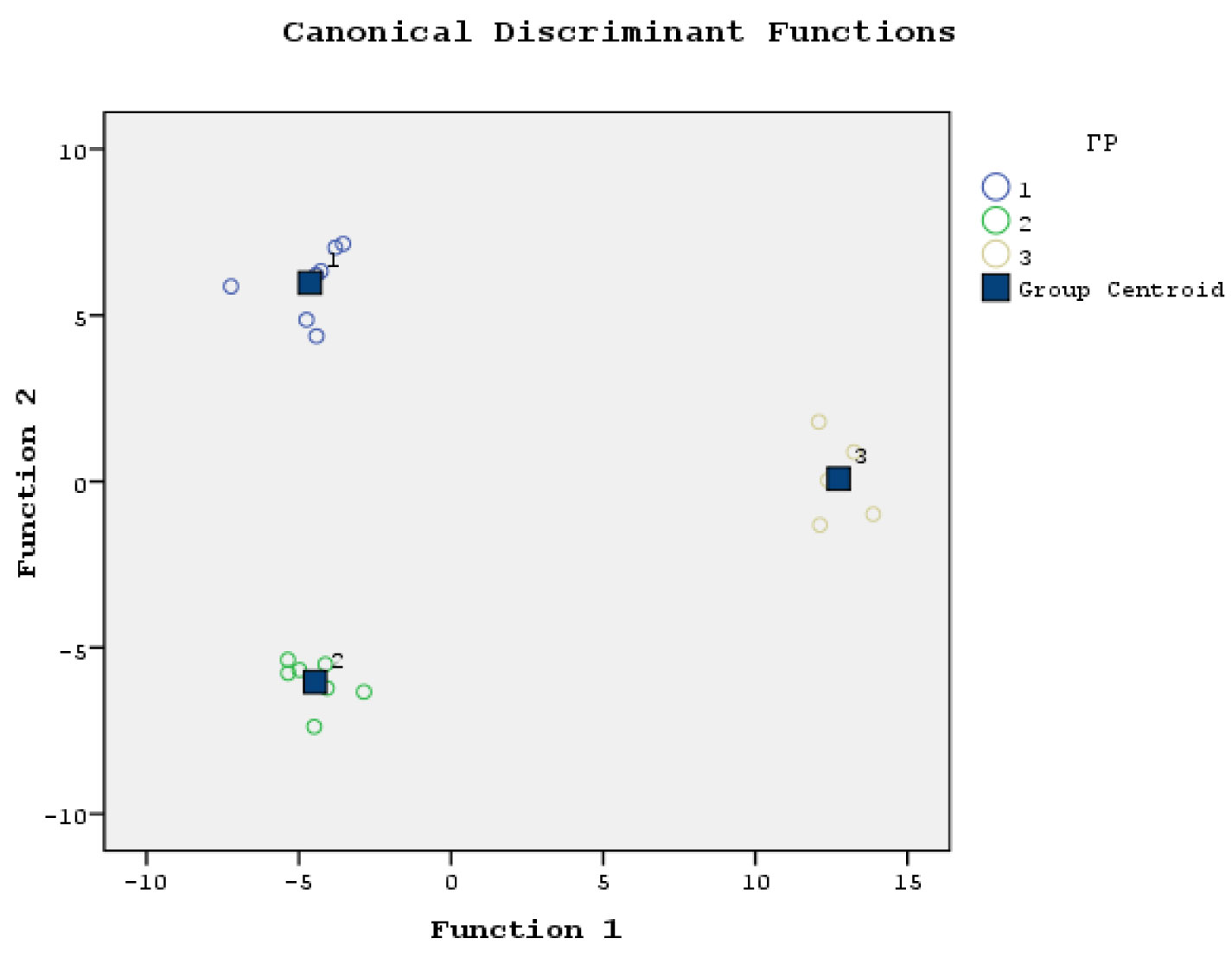
Figure 1. Grouping of athletes
Table 3. Relationship of rating to a number of indicators of physical fitness of present Universal Fight Program
|
№ |
Indicators |
Correlation coefficient |
Degree of relationship |
|
1 |
Number of series: double jab + throw within 1min |
0,823 |
strong |
|
2 |
Push-ups in 30 sec |
0,642 |
average |
|
3 |
Jumping squats in 30 sec |
0,596 |
average |
|
4 |
10 time hip rolls |
0,580 |
average |
|
5 |
Bar hanging leg raises |
0,539 |
average |
|
6 |
Pull-ups |
0,473 |
average |
|
7 |
Standing long jump |
0,334 |
weak |
However, the determined relationships between the exercises and tests that we offered and the athletes' rating are of special interest (Table 4).
As seen from Table 4, the exercises and methods of evaluation of special endurance that we offered display a rather high correlation coefficient, which suggests that these indicators are quite informative. Basing on the HR indices after such basic exercises as barbell squats, deadlift, jerk from rack we can draw a conclusion regarding the functional status of an athlete and the recovery rate after load.
Table 4. Relationship of rating to offered indicators of physical and functional fitness
|
№ |
Indicators |
Correlation coefficient |
Degree of relationship |
|
1 |
HR right after exercise - series: double jab + throw |
0,830 |
strong |
|
2 |
HR 2 minutes after exercise - series: double jab + throw |
0,839 |
strong |
|
3 |
Barbell squats with 70% of 1 RM weight |
0,550 |
average |
|
4 |
HR right after exercise |
0,363 |
weak |
|
5 |
HR 1 minute after |
0,647 |
average |
|
6 |
HR 2 minutes after |
0,768 |
strong |
|
7 |
HR 3 minutes after |
0,879 |
strong |
|
8 |
Deadlift with 70% of 1 RM weight |
0,277 |
weak |
|
9 |
HR right after exercise |
0,643 |
average |
|
10 |
HR 1 minute after |
0, 598 |
average |
|
11 |
HR 2 minutes after |
0, 884 |
strong |
|
12 |
HR 3 minutes after |
0, 888 |
strong |
|
13 |
Jerk from rack with 70% of 1 RM weight |
0, 565 |
average |
|
14 |
HR right after exercise |
0, 526 |
average |
|
15 |
HR 1 minute after |
0, 587 |
average |
|
16 |
HR 2 minutes after |
0, 620 |
average |
|
17 |
HR 3 minutes after |
0, 686 |
average |
Hereafter, we carried out the analysis of significance of differences using the results of Student's t-test registered in different groups of athletes: Group 1 - "strong", Group 2 - nominally "mid-level", Group 3 - nominally "weak".
Table 5. Comparative analysis of Groups 1 and 2 by Student's t-test
|
Indicators |
t |
P |
|
Height |
-1,672 |
P > 0.05 |
|
Weight |
-1,502 |
P > 0.05 |
|
Push-ups in 30 sec |
0,426 |
P > 0.05 |
|
Pull-ups |
0,612 |
P > 0.05 |
|
Hanging leg raises |
0,721 |
P > 0.05 |
|
Jumping squats (in 30 sec) |
1,263 |
P > 0.05 |
|
Standing long jump |
-1,527 |
P > 0.05 |
|
Barbell squats 1 RM |
-0,557 |
P > 0.05 |
|
Barbell squats with 70% of max. weight |
-0,637 |
P > 0.05 |
|
HR right after exercise |
-0,626 |
P > 0.05 |
|
HR 1 minute after |
-0,374 |
P > 0.05 |
|
HR 2 minutes after |
-2,281 |
P ≤ 0.05 |
|
HR 3 minutes after |
-3,376 |
P ≤ 0.05 |
|
Deadlift with max. weight |
-2,290 |
P ≤ 0.05 |
|
Deadlift with 70% of max. weight |
0,632 |
P > 0.05 |
|
HR right after exercise |
-1,427 |
P > 0.05 |
|
HR 1 minute after |
-0,900 |
P > 0.05 |
|
HR 2 minutes after |
-5,394 |
P ≤ 0.05 |
|
HR 3 minutes after |
-7,651 |
P ≤ 0.05 |
|
Jerk from rack with max. weight |
-1,094 |
P > 0.05 |
|
Jerk from rack with 70% of max. weight |
0,632 |
P > 0.05 |
|
HR right after exercise |
-0,574 |
P > 0.05 |
|
HR 1 minute after |
-0,765 |
P > 0.05 |
|
HR 2 minutes after |
0,238 |
P > 0.05 |
|
HR 3 minutes after |
-0,548 |
P > 0.05 |
|
Performance of series: double jab + throw (within 1 min), number of series |
-0,210 |
P > 0.05 |
|
HR right after exercise - series: double jab + throw |
-4,217 |
P ≤0.05 |
|
HR 2 min after exercise - series: double jab + throw |
-1,837 |
P > 0.05 |
|
10 time throws |
-1,521 |
P > 0.05 |
The comparative analysis of Groups 1 and 2 has not revealed any significant differences in the structure of their conditioning. Significant differences between the given groups were registered only with regard to the recovery rate after specific load and deadlift (Table 5). In our view, this is a rather important factor, and we can conclude that the differences in the rating of the examined athletes are displayed in the recovery rate after a specific load. It is thanks to the difference in the functional fitness the athletes from the first group are on a much higher level than the athletes from the second group.
According to the comparative analysis of Groups 2 and 3, the statistically significant differences are observed both in the structure of the conditioning and in the exercises for development of the speed-strength qualities of the leg and back muscles, as well as the recovery rate after load (Table 6).
Table 6. Comparative analysis of Groups 2 and 3 by Student's t-test
|
Indicators |
t |
P |
|
Height |
0,942 |
P > 0.05 |
|
Weight |
1,091 |
P > 0.05 |
|
Push-ups in 30 sec |
5,494 |
P ≤ 0.05 |
|
Pull-ups |
1,196 |
P > 0.05 |
|
Hanging leg raises |
1,836 |
P > 0.05 |
|
Jumping squats (in 30 sec) |
2,793 |
P ≤ 0.05 |
|
Standing long jump |
3,284 |
P ≤ 0.05 |
|
Barbell squats 1 RM |
0,931 |
P > 0.05 |
|
Barbell squats with 70% of max. weight |
7,197 |
P ≤ 0.05 |
|
HR right after exercise |
-1,301 |
P > 0.05 |
|
HR 1 minute after |
-2,532 |
P ≤ 0.05 |
|
HR 2 minutes after |
-6,171 |
P ≤ 0.05 |
|
HR 3 minutes after |
-3,392 |
P ≤ 0.05 |
|
Deadlift with max. weight |
3,991 |
P ≤ 0.05 |
|
Deadlift with 70% of max. weight |
3,078 |
P ≤ 0.05 |
|
HR right after exercise |
-2,271 |
P ≤ 0.05 |
|
HR 1 minute after |
-3,812 |
P ≤ 0.05 |
|
HR 2 minutes after |
-4,481 |
P ≤ 0.05 |
|
HR 3 minutes after |
-3,488 |
P ≤ 0.05 |
|
Jerk from rack with max. weight |
3,181 |
P ≤ 0.05 |
|
Jerk from rack with 70% of max. weight |
2,315 |
P ≤ 0.05 |
|
HR right after exercise |
-2,649 |
P ≤ 0.05 |
|
HR 1 minute after |
-5,205 |
P ≤ 0.05 |
|
HR 2 minutes after |
-5,352 |
P ≤ 0.05 |
|
HR 3 minutes after |
-6,081 |
P ≤ 0.05 |
|
Performance of series: double jab + throw (in 1 min), number of series |
1,847 |
P > 0.05 |
|
HR right after exercise - series: double jab + throw |
-1,671 |
P > 0.05 |
|
HR 2 min after exercise - series: double jab + throw |
-5,754 |
P ≤ 0.05 |
|
10 time throws |
-0,667 |
P > 0.05 |
Hereafter, we evaluated the functional status of fighters by means of the analysis of their HR dynamics after performing the offered exercises by the method "to failure" in each of the groups of "strong", nominally "mid-level", and nominally "weak" athletes.
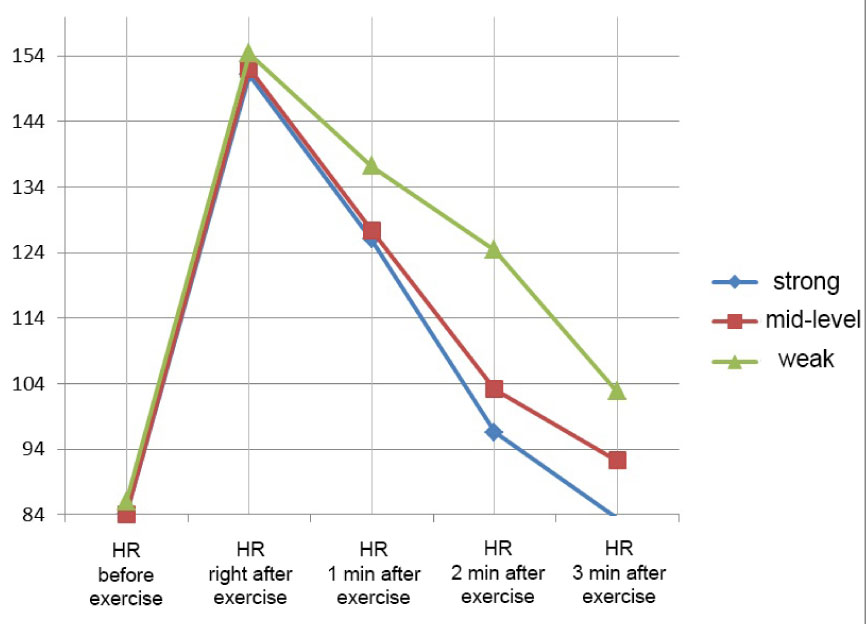
Fig. 2. Dynamics of HR recovery after exercise "barbell squats by method "to failure"
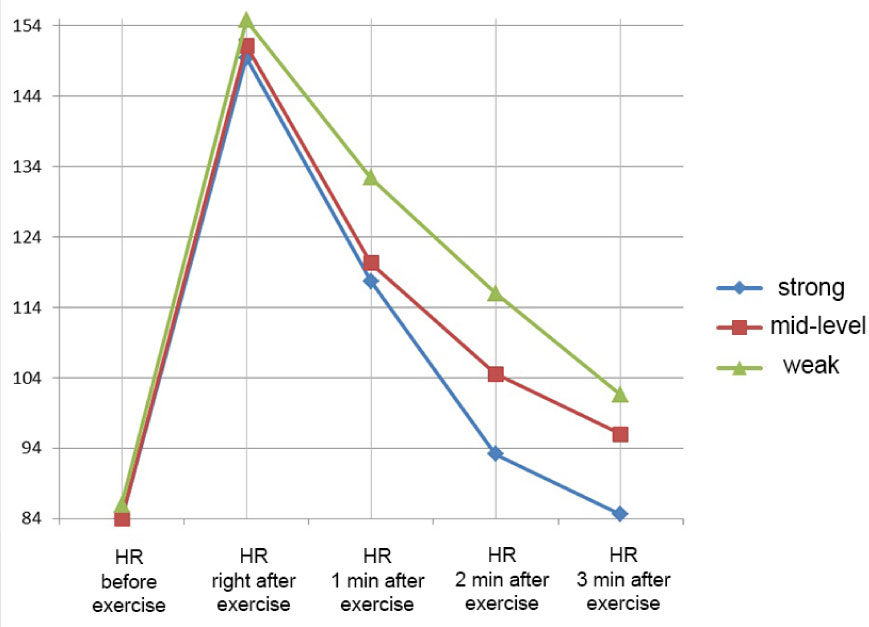
Fig. 3. Dynamics of HR recovery after exercise "deadlift by method "to failure"
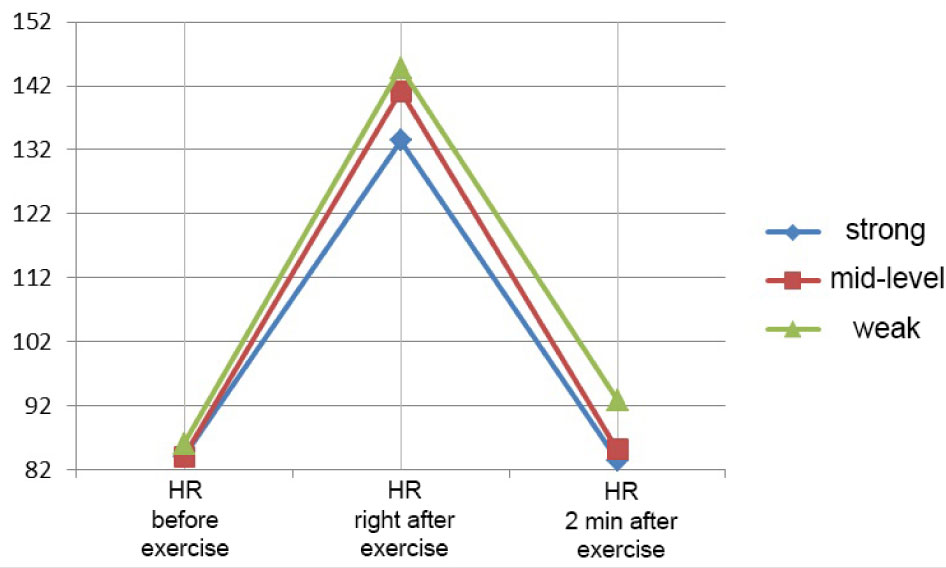
Fig. 4. Dynamics of HR recovery after exercise "series: double jab + throw within 1 min"
Proceeding from the dynamics of HR recovery after exercises - barbell squats with 70% of maximum weight, deadlift with 70% of maximum weight (Fig. 2, 3), and double jab + throw in 1 minute (Fig. 4), the recovery rate in the group of "strong" athletes was higher than in the groups of nominally "mid-level" and "weak" ones. In turn, this was indicative of a higher level of functional and special fitness of the athletes from the "strong" group and of the informational content of the tests we offered, since they had a higher correlation coefficient in relation to the rating (Table 4) and were sufficiently reflective of the requirements to special physical training of the athletes specializing in complex (mixed) martial arts.
Conclusions.
1. The main physical qualities in complex (mixed) martial arts were proved to be strength endurance of the shoulder muscles, speed-strength qualities of the back and leg muscles, as well as special endurance.
2. Athletes with different fitness levels are distinguished by the level of development of special endurance and, what is most important, the rate of recovery after exercise.
3. The analysis of the program and control-transfer standards on conditioning and special physical training for training groups of athletes (16-18 years) involved in complex martial arts (through the example of universal fight) showed that the given program, on the whole, reflects all the necessary indices of evaluation of development of physical qualities. However, in order to do a fully-featured testing it is reasonable to add to this complex the proven tests of the level of development of speed-strength abilities and endurance of the leg, back and shoulder muscles.
4. We have justified the need for implementation of the following exercises and tests:
I. To determine speed-strength abilities and strength endurance of the leg, back and shoulder muscles:
a) back squats with 70% of maximum weight (number of times).
b) deadlift with 70% of maximum weight (number of times).
c) jerk from rack with 70% of maximum weight (number of times).
II. To measure HR right after exercises:
a) measurement of HR right after, 1 minute after, 2 minutes after, 3 minutes after the following exercises - barbell squats and deadlift with 70% of maximum weight;
b) measurement of HR right after and 2 minutes after exercise - series: double jab + throw within 1 minute.
References
- Ashkinazi, S.M. Universal fight (UNIFIGHT): Curriculum for SCSS, SCSSOR, SPC (2nd ed, rev. and sup.) / S.M. Ashkinazi, S.P. Novikov, K.V. Klimov // Ministry of sport and tourism: St. Petersburg: Olimp-Spb, 2012. – 140 P. (In Russian)
- Klimov, K.V. The content and methodology of technical and tactical training of athletes in complex martial arts: Ph.D. thesis / K.V. Klimov. – St. Petersburg, 2007. – 163 P. (In Russian)
- Obvintsev, A.A. Modern sports, applied martial arts and martial arts in training of military men and anti-terror units / A.A. Obvintsev, S.M. Ashkinazi // Proceedings of the IV Intern. Congress "Sport. Man. Health". – St. Petersburg: Olimp-Spb, 2013. – 256 P. (In Russian)
Corresponding author: panfilio@spmi.ru


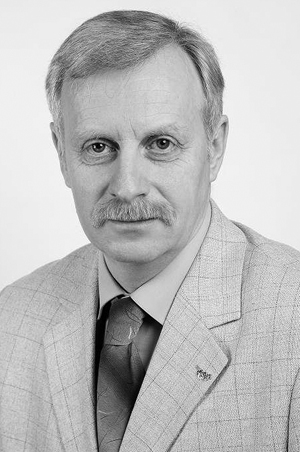

 Журнал "THEORY AND PRACTICE
Журнал "THEORY AND PRACTICE